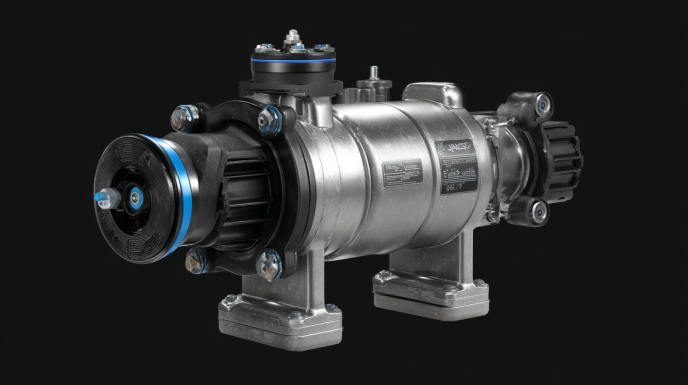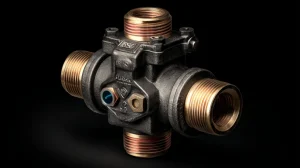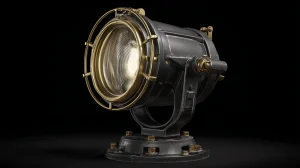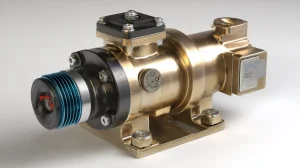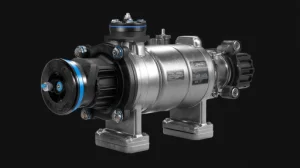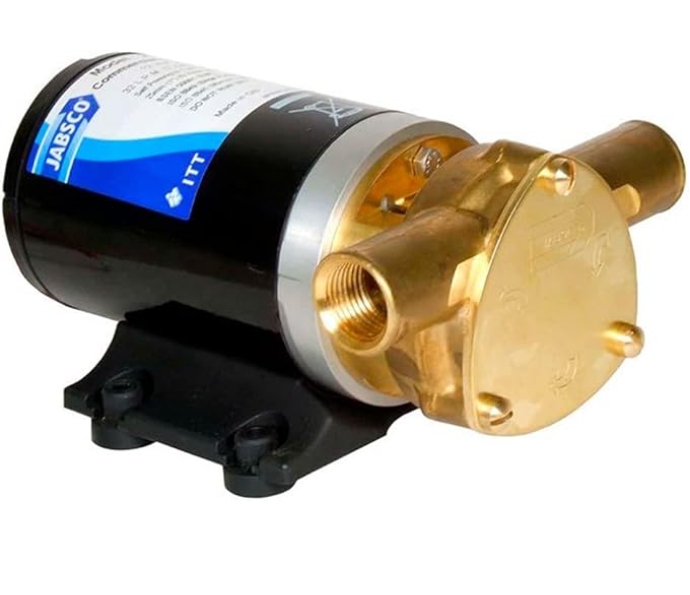
Jabsco 23680-4003 Water Puppy Pump Bronze Commercial Duty 12 Volt Boat Plumbing Item
- Package Dimensions: 13.716 L x 28.956H x14.224W(centimeters)
- Country of Origin: Mexico
- No batteries required
- Product Type: FISHING EQUIPMENT
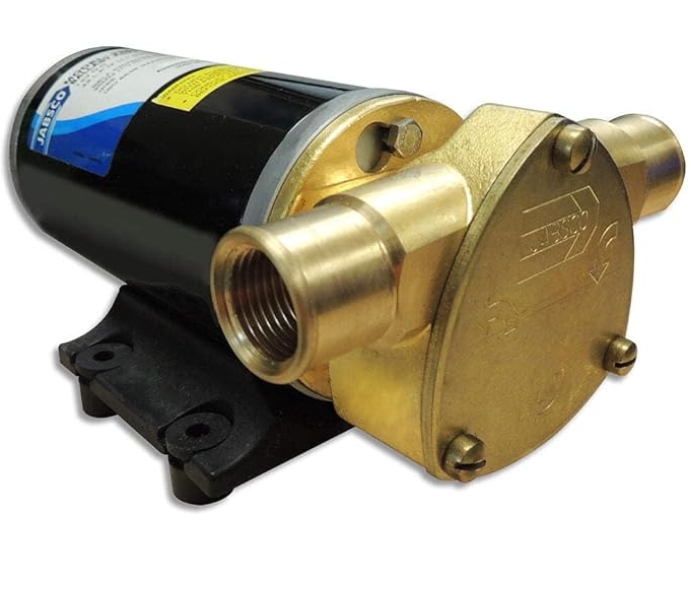
Jabsco Ballast King Bronze DC Pump w/Reversing Switch – 15 GPM
- Great Product
- Item Package Dimension: 11.54L x 5.75W x 5.35H inches
- Item Package Weight – 8.81 Pounds
- Item Package Quantity – 1
- Product Type – WATER PUMP
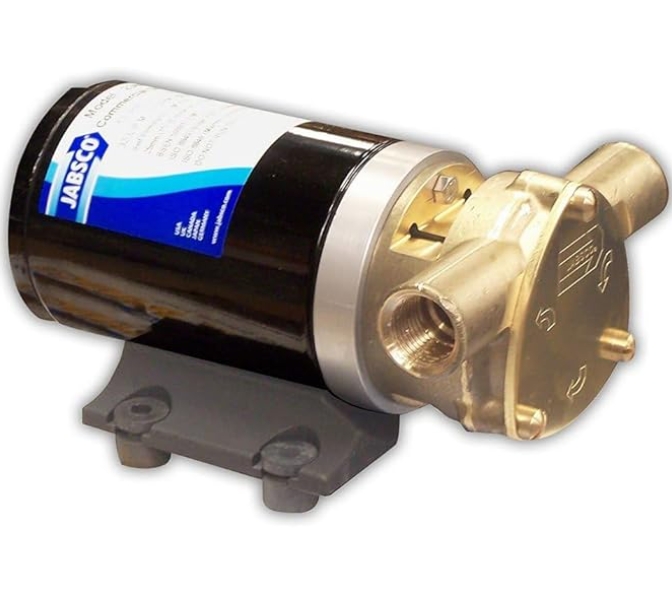
Jabsco 18670 Series Marine Water Puppy Bilge / Sump Flexible Impeller Commercial Duty Pump 470-GPH,15-Amp Non-CE, 1/2″ NPT Ports
- Flow rate: 8 USgallons/min (30.4 Litres/min), self-priming from dry up to 1.2m (4ft)
- Small bilge debris present no problem to these bronze bodied, flexible impeller pumps
- Simple design means fewer wearing parts
- Use for bilge pumping, livewell circulation, washdown and general pumping requirements
Navigating the Waters of Reliability, Performance, and Longevity
In the world of marine equipment, few names carry the weight and reputation of Jabsco. Whether you’re a seasoned sailor, a weekend warrior on the water, or someone looking for reliable pumping solutions for various applications, understanding the ins and outs of Jabsco pumps can make all the difference in your experience. The right pump isn’t just an accessory—it’s the beating heart of your vessel’s essential systems.
I’ve spent years working with various marine systems, and time and again, Jabsco has proven itself as a standout brand in the pumping world. Today, I’m diving deep into everything you need to know about these remarkable pieces of engineering—from their basic functionality to advanced troubleshooting techniques that could save you precious time on the water.
What Is a Jabsco Pump Used For?
Jabsco pumps are versatile workhorses designed to handle a wide range of fluid transfer applications. Originally making their mark in the marine industry, these pumps have expanded their reach into various sectors where reliable fluid movement is crucial.
At their core, Jabsco pumps serve one fundamental purpose: moving fluids from one place to another. But this simple description hardly does justice to the breadth of their applications. On boats and marine vessels, Jabsco pumps are the unsung heroes that:
- Circulate cooling water through engines
- Supply fresh water to sinks, showers, and toilets
- Empty waste tanks and bilges
- Provide pressure for deck washing systems
- Transfer fuel between tanks
- Support air conditioning systems
- Operate marine toilets
Beyond the marine world, you’ll find Jabsco pumps hard at work in:
- Agricultural irrigation and spraying systems
- Food and beverage processing
- Chemical transfer operations
- Industrial cleaning applications
- RVs and mobile homes for water systems
- Commercial kitchen equipment
What makes Jabsco pumps particularly valuable is their ability to handle a variety of fluids—from fresh water to saltwater, from fuel to waste—with reliable efficiency and durability. Their adaptability has made them indispensable in environments where failure simply isn’t an option.
The Science Behind the System: How Does a Jabsco Pump Work?
Understanding how your Jabsco pump operates isn’t just for the mechanically curious—it provides valuable insight when it comes time to troubleshoot or perform maintenance. While Jabsco manufactures several different pump types, each operates on a few key principles.
Impeller Pumps
The flexible impeller pump is perhaps Jabsco’s most iconic design. Here’s how it works:
- The pump contains a flexible rubber impeller with vanes (blades) mounted on a rotating shaft.
- As the impeller rotates within an offset chamber, the vanes flex and create varying volumes.
- This creates a vacuum on the inlet side, drawing fluid into the pump.
- As rotation continues, the fluid is trapped between the vanes and carried around to the outlet.
- At the outlet, the vanes compress, forcing the fluid out under pressure.
This elegant design offers several advantages, including self-priming capability (able to draw fluid up to 8 feet vertically), gentle handling of sensitive fluids, and the ability to pass small particles without clogging.
Diaphragm Pumps
Jabsco’s diaphragm pumps operate on a different principle:
- A flexible diaphragm is moved back and forth by a connecting rod or electrical solenoid.
- When the diaphragm moves outward, it creates a vacuum that opens the inlet valve and draws fluid in.
- When the diaphragm moves inward, it creates pressure that closes the inlet valve, opens the outlet valve, and forces fluid out.
- One-way check valves ensure fluid moves in only one direction.
Diaphragm pumps excel at providing consistent pressure, running dry without damage, and handling varying flow demands efficiently.
Centrifugal Pumps
For applications requiring higher flow rates, Jabsco’s centrifugal pumps offer:
- A spinning impeller with rigid vanes that fling fluid outward using centrifugal force.
- Fluid enters at the center (eye) of the impeller and exits at the outer edge.
- The pump housing captures this energy and directs it to the outlet.
While centrifugal pumps typically require priming (pre-filling with fluid), they excel at moving large volumes continuously with minimal pulsation.
Navigating the Catalog: Different Types of Jabsco Pumps
Jabsco’s extensive catalog can initially seem overwhelming, but understanding the major categories helps narrow down the right pump for your specific needs.
Marine Toilet Pumps
Designed specifically for waste management on boats, Jabsco’s marine toilet pumps come in manual and electric varieties. The manual versions use a lever action to create suction and discharge, while electric models offer push-button convenience with macerator functions that break down waste for easier processing.
Water Pressure Pumps
These diaphragm-style pumps create on-demand pressurized water systems for boats and RVs. When you open a faucet or shower, the pump senses the pressure drop and activates automatically. Jabsco’s Par-Max series is particularly popular, offering various flow rates and pressure settings to match different vessel sizes.
Bilge Pumps
Designed to remove unwanted water from the lowest part of a boat (the bilge), these pumps are crucial safety equipment. Jabsco’s bilge pumps range from compact 500 GPH (gallons per hour) models for small vessels to robust 4000+ GPH versions for larger boats. Many include automatic float switches that activate when water reaches a certain level.
Engine Cooling Pumps
These flexible impeller pumps circulate cooling water through marine engines. They’re designed to handle the harsh marine environment and provide reliable cooling even under demanding conditions. The bronze and stainless steel construction options offer excellent corrosion resistance in saltwater applications.
General Purpose Utility Pumps
Versatile workhorses, these pumps handle everything from water transfer to deck washing, fish box drainage, and livewell circulation. Models like the Jabsco Amazon Universal offer remarkable flexibility for various boating needs.
Oil Change Pumps
Specifically designed to make engine maintenance easier, these pumps connect to a drill to quickly extract oil from marine engines during oil changes. They’re compact, efficient, and save considerable time and mess compared to traditional oil change methods.
High-Pressure Washdown Pumps
Perfect for cleaning decks, equipment, and catches, these pumps deliver a powerful spray that cuts through salt, fish blood, and other marine grime. Most include pressure switches for on-demand operation and thermal overload protection.
Installation Insights: Setting Up Your Jabsco Pump for Success
Proper installation is perhaps the single most important factor in ensuring your Jabsco pump’s longevity and reliable operation. While specific installation steps vary by model, these universal principles apply to most Jabsco pump installations:
Location Considerations
- Mount the pump at or below the fluid source level whenever possible for optimal priming.
- Select a dry location where the pump won’t be submerged.
- Ensure adequate ventilation, especially for electric models that generate heat.
- Allow sufficient clearance for maintenance access.
- Choose a location with minimal vibration to reduce wear and noise.
Plumbing Best Practices
- Use hoses rated for the specific fluid being pumped (especially important for fuel pumps).
- Select hose diameters that match or exceed the pump’s port sizes—restrictions reduce performance.
- Keep hose runs as short and straight as possible to minimize resistance.
- Install a strainer on the inlet side to prevent debris from entering and damaging the pump.
- Use double hose clamps at all connections for critical applications.
- Include flexible sections to absorb vibration and prevent stress on connections.
Electrical Installation (For Electric Models)
- Follow the manufacturer’s wiring diagram precisely.
- Use marine-grade wire sized appropriately for the current draw and distance.
- Install the recommended fuse or circuit breaker at the power source.
- Ensure all electrical connections are waterproof and corrosion-resistant.
- Include a proper switch rated for the pump’s amperage.
- Consider adding a soft-start circuit for larger pumps to reduce startup current spikes.
Testing After Installation
Before considering the installation complete:
- Check for leaks at all connections under operating pressure.
- Verify proper priming and flow rates.
- Listen for unusual noises that might indicate improper installation.
- Measure actual current draw against specifications.
- Test all control functions (automatic switches, pressure cutoffs, etc.).
Taking the time to perform a meticulous installation pays dividends in reliability and longevity. Many Jabsco pump issues can be traced back to installation shortcuts or overlooked details.
Real-World Applications: Jabsco Pumps in Action
The versatility of Jabsco pumps becomes apparent when you observe the diverse ways they’re employed across various industries and applications. Here’s a closer look at how these pumps solve real-world challenges:
Marine Applications
The marine environment is particularly demanding, requiring equipment that can withstand corrosion, vibration, and intermittent use. Jabsco pumps excel here by:
- Providing reliable freshwater pressure systems that deliver consistent water flow for onboard showers, sinks, and appliances
- Emptying holding tanks efficiently through macerator pumps that break down waste
- Keeping bilges dry with automatic pumps that activate when water is detected
- Supporting air conditioning systems with circulation pumps built to handle saltwater
- Providing engine cooling through impeller pumps designed specifically for marine engines
- Delivering high-pressure deck washdown capabilities for cleaning
Commercial Fishing Operations
Commercial fishing vessels rely on Jabsco pumps for:
- Maintaining livewells with oxygen-rich circulating water
- Processing catches with washdown systems
- Transferring fish slurry during processing
- Handling bait tank circulation
- Managing waste systems during extended trips
- Providing emergency dewatering capabilities
Industrial Applications
Beyond the water, Jabsco pumps handle industrial challenges including:
- Chemical transfer in manufacturing processes
- Food-grade pumping in beverage and food production
- Irrigation systems in agriculture
- Water circulation in commercial aquariums and aquaculture
- Sampling systems in quality control operations
The common thread across all these applications is reliability under pressure. When a system relies on consistent fluid movement—whether it’s cooling an engine, supplying drinking water, or processing valuable products—a pump failure can cascade into significant problems. Jabsco’s reputation is built on minimizing these risks.
Troubleshooting Guide: When Your Jabsco Pump Isn’t Performing
Even the best-maintained pumps occasionally develop issues. Knowing how to diagnose and address common problems can save you time, money, and frustration. Here’s a systematic approach to troubleshooting Jabsco pumps:
Pump Runs But Doesn’t Move Fluid
This common issue typically stems from:
- Air leaks in the inlet line preventing proper priming
- Worn impeller or diaphragm failing to create proper suction
- Blocked inlet strainer restricting flow
- Excessive inlet lift exceeding the pump’s priming capability
- Incorrect rotation direction (particularly after service)
Solution steps:
- Check all inlet connections for air leaks using soapy water
- Inspect the impeller or diaphragm for wear or damage
- Clean the inlet strainer and check for blockages
- Verify that the vertical lift doesn’t exceed specifications
- Confirm proper motor rotation
Pump Makes Unusual Noises
Abnormal sounds often indicate:
- Cavitation (fluid vaporizing due to excessive suction)
- Bearing wear or failure
- Impeller contacting the housing
- Loose mounting causing vibration
- Air in the system
Solution steps:
- Reduce inlet restrictions or vertical lift to prevent cavitation
- Inspect and replace worn bearings
- Check impeller clearance and adjust as needed
- Tighten mounting hardware and add vibration dampening
- Properly bleed air from the system
Reduced Flow or Pressure
When performance drops, consider:
- Partially clogged inlet strainer
- Worn impeller or diaphragm
- Low voltage to electric motor
- System leaks reducing pressure
- Incorrect pump speed
Solution steps:
- Clean or replace the inlet strainer
- Replace the impeller or diaphragm
- Check voltage at the pump during operation
- Inspect the entire system for leaks
- Verify proper motor RPM or drive belt tension
Pump Cycles Rapidly (Pressure Pumps)
This “short cycling” typically indicates:
- System leaks causing pressure drops
- Faulty pressure switch
- Trapped air in the system
- Inadequate expansion tank or accumulator
Solution steps:
- Check for leaks at all fittings and fixtures
- Adjust or replace the pressure switch
- Bleed air from the system completely
- Verify proper accumulator pressure and function
Pump Overheats
Excessive heat can damage seals and components, and usually stems from:
- Running dry without fluid
- Operating against a closed outlet (deadheading)
- Excessive fluid temperature
- Voltage issues
- Prolonged operation beyond duty cycle
Solution steps:
- Ensure adequate fluid supply
- Never operate with a closed outlet valve
- Check fluid temperature against specifications
- Verify proper voltage and current draw
- Allow appropriate cooling periods for intermittent-duty pumps
Preventative Maintenance: Extending Your Jabsco Pump’s Lifespan
Regular maintenance dramatically extends pump life and prevents inconvenient failures. Develop a maintenance schedule based on:
Routine Visual Inspections (Monthly)
- Check for fluid leaks around seals and connections
- Inspect wiring for corrosion or damage
- Look for unusual vibration or movement during operation
- Verify proper mounting security
- Clean external surfaces to prevent corrosion
Seasonal Service (Every 300 Hours or Annually)
- Replace impellers in flexible impeller pumps
- Inspect and clean check valves in diaphragm pumps
- Check and replace worn seals
- Lubricate bearings according to manufacturer specifications
- Clean and inspect inlet strainers thoroughly
- Test pressure switches and control systems
- Measure voltage and current draw under load
Comprehensive Service (Every 1000 Hours or Bi-Annually)
- Disassemble and thoroughly inspect all components
- Replace all wear parts (impellers, seals, diaphragms)
- Check shaft and bearing tolerance
- Inspect motor brushes in DC motors
- Clean all internal passages and check for corrosion
- Verify proper impeller clearance
- Replace mounting hardware showing corrosion
Winterization (For Seasonal Use)
If your pump will be inactive during cold months:
- Drain all fluid to prevent freeze damage
- Run non-toxic antifreeze through the system in areas subject to freezing
- Disconnect and clean inlet strainers
- Loosen drive belts to prevent stretching during storage
- Cover the pump to protect from dust and moisture
- For electric pumps, consider removing and storing in a climate-controlled environment
Preventative maintenance is always more cost-effective than emergency repairs. A well-maintained Jabsco pump often lasts 5-10 years or more, while neglected units might fail within a season or two of heavy use.
Purchasing Guidance: Where to Buy and What to Expect
When it’s time to purchase a new Jabsco pump or replacement parts, knowing where to shop and what to expect in terms of cost helps make informed decisions.
Reliable Purchase Channels
- Marine Supply Retailers: Establishments like West Marine, Defender Marine, and local boat supply shops typically carry a good selection of Jabsco products with knowledgeable staff who can help with selection.
- Online Marine Specialists: Websites dedicated to marine equipment often offer the broadest selection of Jabsco pumps with detailed specifications and competitive pricing.
- General Online Retailers: Amazon, eBay, and similar platforms carry Jabsco products, but buyer beware—counterfeit parts have been reported. Stick with listings directly from Jabsco or authorized dealers.
- Industrial Supply Companies: For commercial applications, companies like Grainger, MSC Industrial, and McMaster-Carr carry Jabsco’s industrial pump line.
- Direct from Manufacturer: In some cases, especially for specialized or high-volume purchases, buying directly from Jabsco or through authorized distributors may be possible.
Price Range Expectations
Jabsco pump pricing varies widely based on type, capacity, and features:
- Basic Manual Pumps: $30-$150 for simple hand or drill-operated transfer pumps
- Standard Electric Water Pressure Pumps: $100-$300 for common freshwater system pumps
- Marine Toilet Systems: $150-$700 depending on manual vs. electric and features
- High-Capacity Washdown Pumps: $200-$500 for deck and equipment cleaning systems
- Specialized Engine Cooling Pumps: $200-$800 depending on engine size and material
- Commercial/Industrial Models: $500-$2,000+ for high-volume or specialized applications
Replacement parts pricing examples:
- Impellers: $15-$50
- Seal kits: $25-$75
- Complete rebuild kits: $50-$200
- Control boards for electronic models: $100-$300
What to Consider Before Purchasing
- Verify Compatibility: Ensure the pump matches your specific application requirements (voltage, flow rate, pressure, fluid type).
- Check Authenticity: Look for genuine Jabsco packaging and authentication features to avoid counterfeits.
- Warranty Coverage: Standard Jabsco warranties range from 1-3 years depending on the model. Some retailers offer extended coverage.
- Availability of Parts: Consider how readily available replacement parts will be for your chosen model.
- Total Cost of Ownership: Sometimes spending more initially on a higher-quality model reduces long-term costs through better efficiency and durability.
The Jabsco Advantage: Benefits That Make the Difference
What sets Jabsco pumps apart from competitors? After decades in the marine and industrial pumping business, Jabsco has established several key advantages:
Engineering Excellence
Jabsco’s engineering team continuously refines their designs based on real-world feedback and testing. This iterative improvement approach has led to innovations like:
- Self-priming designs that can pull fluid up to 8 vertical feet
- Run-dry protection in newer models to prevent damage during accidental dry operation
- Noise-dampening technologies that reduce operational sound
- Multi-directional heads that allow flexible installation orientations
- Energy-efficient motors that reduce power consumption without sacrificing performance
Material Quality
The materials used in Jabsco pumps are specifically selected for their application environments:
- Marine-grade bronze and stainless steel options for saltwater resistance
- FDA-compliant materials for food and beverage applications
- Chemical-resistant components for industrial uses
- UV-stabilized plastics for exterior applications
- Specially formulated impeller compounds that balance flexibility with wear resistance
System Integration
Jabsco designs their pumps to work as part of larger systems, not just as standalone components:
- Standardized port sizes that match common marine plumbing
- Electrical systems compatible with boat and RV power standards
- Footprint dimensions that allow drop-in replacement of older models
- Control interfaces that work with modern vessel management systems
- Modular designs that facilitate easier maintenance and upgrades
Global Support Network
With distribution in over 100 countries, Jabsco offers something many competitors cannot match:
- Parts availability almost anywhere in the world
- Service knowledge that extends to remote locations
- Consistent warranty support regardless of purchase location
- Multi-language documentation and support
- Training programs for service technicians worldwide
Hands-On: Replacing Parts on Your Jabsco Pump
Knowing how to replace common wear items extends your pump’s life and saves on service costs. Here’s a practical guide to replacing the most common parts:
Impeller Replacement
The flexible impeller is typically the first component to wear out in Jabsco’s popular flexible impeller pumps. Replacing it is straightforward:
- Close any inlet and outlet valves to prevent fluid spillage
- Remove the pump’s end cover by unscrewing the retaining screws
- Extract the worn impeller using impeller pullers or two flathead screwdrivers
- Note the direction of the impeller vanes (they should curve in the direction of rotation)
- Lubricate the new impeller with glycerin or dish soap (never petroleum-based lubricants)
- Insert the new impeller, aligning the drive slot with the shaft
- Replace the end cover with a new gasket if needed
- Tighten screws in a star pattern to ensure even pressure
Diaphragm Replacement
For diaphragm-style pumps like the Par-Max series:
- Release system pressure completely
- Disconnect electrical connections and tag wires for reassembly
- Remove the pump head screws in a cross pattern to prevent warping
- Carefully separate the pump head to expose the diaphragm
- Note the exact position of the diaphragm and any alignment marks
- Remove the diaphragm assembly, typically secured by a central screw or nut
- Install the new diaphragm, precisely matching the original orientation
- Reassemble in reverse order, using new gaskets as recommended
- Tighten fasteners to specified torque in a cross pattern
Seal Replacement
Seal failure often manifests as leaking around the shaft:
- Disassemble the pump to access the shaft seals
- Remove worn seals using a seal puller, being careful not to damage the shaft
- Clean the seal seats thoroughly, removing any corrosion or debris
- Inspect the shaft for scoring or damage that might compromise new seals
- Lubricate new seals with appropriate lubricant (typically silicone grease)
- Install seals using proper seal drivers to ensure square seating
- Reassemble the pump and test for leaks
Motor Brushes (DC Motors)
For electric DC pumps, motor brushes typically require replacement every 1,000-1,500 hours:
- Disconnect all power sources
- Locate the brush caps (typically on the motor housing opposite the shaft end)
- Unscrew the brush caps and carefully remove old brushes
- Note the orientation and any wear patterns
- Insert new brushes in the same orientation
- Replace brush caps and tighten securely
- Run the motor for a few minutes to allow brushes to “seat” properly
Marine Mastery: Best Jabsco Pumps for Boating Applications
For boat owners, selecting the right pump for each onboard system is crucial. Here are the standout Jabsco models for common marine applications:
Freshwater Pressure Systems
The Jabsco Par-Max Plus series dominates this category with several advantages:
- Multi-chamber diaphragm design for smooth, consistent pressure
- Built-in pressure switch for automatic operation
- Available in various flow rates (1.9 to 5.0 GPM) to match vessel size
- Quiet operation compared to competing models
- Available in 12V, 24V, and 115V versions
For smaller vessels or backup systems, the Par-Max 1.0 offers excellent reliability in a compact package.
Toilet Systems
Marine toilets face some of the harshest conditions on board. Jabsco offers several excellent options:
The Jabsco Manual Marine Toilet remains the gold standard for reliability with simple hand-pump operation and minimal maintenance requirements.
For those wanting electric convenience, the Jabsco Quiet Flush Electric Toilet offers:
- Near-silent operation
- Multiple flush modes to conserve water
- Powerful macerator that prevents clogs
- Porcelain bowl options for home-like comfort
Bilge Pumps
The Jabsco Amazon Warrior series stands out for:
- Exceptional debris handling capability
- Available capacities from 500 to 4000 GPH
- Options for manual, automatic, or panel-controlled operation
- Durable construction that withstands harsh bilge environments
Engine Cooling
For engine cooling applications, the Jabsco Impeller Pump with bronze construction offers:
- Excellent corrosion resistance in saltwater
- Direct replacement compatibility with many marine engines
- Field-serviceable design allowing impeller changes without removing the pump
- Available in multiple shaft configurations to match different engines
Washdown Systems
The Jabsco Washdown Pump Kit provides:
- High-pressure output perfect for cleaning decks and equipment
- Self-priming capability up to 6 feet
- Included pressure switch and accumulator tank for smooth operation
- Complete installation components in one package
Keeping It Clean: Maintenance and Cleaning Procedures
Proper cleaning procedures extend pump life and maintain peak performance. Here’s how to properly clean different Jabsco pump types:
Flexible Impeller Pumps
- Flush with fresh water immediately after pumping saltwater or contaminated fluids
- For more thorough cleaning:
- Disconnect inlet and outlet hoses
- Circulate a mild vinegar solution (10%) through the pump to remove mineral deposits
- Follow with clean fresh water flush
- For severe contamination, remove the end cover and clean the impeller chamber with a soft brush
- Never use harsh solvents that could damage rubber components
Diaphragm Pumps
- For routine cleaning, simply run clean water through the system
- For deeper cleaning:
- Mix a solution of white vinegar and water (1:3 ratio)
- Disconnect the outlet hose and place it in a bucket
- Draw the cleaning solution through the pump for 2-3 minutes
- Follow with a clean water flush
- For winterization or long-term storage:
- Run non-toxic antifreeze through the system
- Leave some antifreeze in the pump body to prevent internal corrosion
Macerator Pumps (For Marine Toilets)
These require special attention due to their waste handling function:
- After each pumping cycle, flush with clean water to remove waste residue
- Periodically use a marine toilet cleaner specifically formulated for macerating systems
- Avoid chlorine bleach, which can damage rubber components
- For serious clogs or odor issues:
- Disconnect the pump
- Soak in a solution of enzymatic cleaner
- Use a small brush to clean the macerator blades
- Rinse thoroughly before reinstallation
Centrifugal Pumps
- These generally require minimal cleaning unless used with contaminated fluids
- If performance decreases:
- Disassemble according to manufacturer instructions
- Check for debris around the impeller
- Clean the volute chamber with a soft brush
- Inspect for mineral buildup and remove with vinegar solution if present
Common Problems and Preemptive Solutions
Understanding the most frequent issues with Jabsco pumps allows you to prevent problems before they occur. Here are the top challenges and their solutions:
Impeller Failure
Problem: Rubber impellers can fail prematurely, especially when run dry or exposed to chemicals.
Solution:
- Install a vacuum gauge on the inlet side to monitor for suction problems
- Consider an electronic run-dry protection system
- Replace impellers annually as preventative maintenance
- Keep spare impellers on board, properly stored with glycerin coating
- Ensure proper impeller material for the specific fluid being pumped
Pressure Switch Issues
Problem: Pressure switches in on-demand systems can fail, causing pumps to run continuously or not start when needed.
Solution:
- Install a secondary pressure gauge to monitor system pressure
- Clean switch diaphragms annually to prevent mineral buildup
- Adjust pressure settings to manufacturer specifications
- Consider upgrading to newer electronic pressure sensing systems
- Install a manual override switch for emergency operation
Electrical Corrosion
Problem: Marine environments are particularly harsh on electrical connections.
Solution:
- Use heat-shrink marine-grade terminals for all connections
- Apply dielectric grease to connections before assembly
- Install pumps in dry locations whenever possible
- Use tinned marine wire rather than standard copper
- Check connections seasonally for signs of corrosion
- Consider conformal coating circuit boards in electronic models
Noise and Vibration
Problem: Pumps can become noisy over time, indicating potential issues.
Solution:
- Mount pumps on rubber isolators to reduce transmitted vibration
- Ensure proper alignment during installation
- Use flexible connections on inlet and outlet ports
- Check for proper impeller clearance during maintenance
- Add accumulator tanks to reduce water hammer in pressure systems
- Inspect for loose components during routine maintenance
Priming Procedures: Getting Your Pump Ready to Work
Many Jabsco pumps are self-priming, but proper priming procedures ensure reliable operation and prevent damage. Here’s how to prime different pump types:
Flexible Impeller Pumps
- Fill the pump body with fluid through either the inlet or outlet port
- Ensure the inlet hose is airtight with proper connections
- Keep the vertical lift below manufacturer specifications (typically 6-8 feet)
- Run the pump briefly to establish prime
- If prime isn’t established within 30 seconds, stop and check for air leaks
Centrifugal Pumps
Unlike flexible impeller models, centrifugal pumps typically require external priming:
- Remove the priming plug on the pump body
- Fill the pump body completely with fluid
- Replace the priming plug securely
- Ensure the inlet line is filled with fluid
- Start the pump and confirm proper operation
Diaphragm Pumps
Most diaphragm pumps are self-priming but benefit from:
- Minimizing initial lift distance during priming
- Ensuring leak-free inlet connections
- Checking inlet strainers for clogs that prevent priming
- Operating briefly at lower back pressure until prime is established
Tips for Difficult Priming Situations
When pumps won’t prime despite following standard procedures:
- Check for air leaks by applying soapy water to connections and looking for bubbles
- Temporarily reduce vertical lift if possible
- Verify inlet hose isn’t collapsing under suction
- For persistent problems, install a small primer bulb in the inlet line
- Check for debris under valve seats in diaphragm pumps
Freshwater vs. Seawater: Choosing the Right Pump
Jabsco offers pumps designed for both freshwater and seawater applications, but material selection is crucial:
Freshwater-Only Pumps
Typically feature:
- Thermoplastic bodies that reduce cost and weight
- Stainless steel fasteners
- Standard rubber compounds for impellers and diaphragms
- Aluminum or zinc components that wouldn’t survive in saltwater
These pumps offer excellent value for freshwater applications but will rapidly deteriorate in saltwater environments.
Saltwater-Compatible Pumps
Designed with:
- Bronze or glass-filled nylon bodies resistant to corrosion
- 316 stainless steel fasteners and shafts
- Special nitrile or neoprene compounds for impellers that resist saltwater
- Sacrificial zinc anodes in some models to prevent galvanic corrosion
- Special seals designed for the harsh saltwater environment
Dual-Purpose Options
Some Jabsco pumps are explicitly designed for both environments:
- The Jabsco Amazon Universal series offers excellent versatility
- Engine cooling pumps with bronze construction handle both fresh and salt water
- Many toilet pumps are dual-rated with appropriate materials
Converting Between Uses
If you must use a pump in a different environment than intended:
- Flush thoroughly when switching between fresh and salt water
- Increase maintenance frequency and inspections
- Consider adding inline sacrificial anodes for saltwater use
- Replace rubber components more frequently when used in non-ideal conditions
Selecting the Perfect Pump for Your Vessel
Choosing the right Jabsco pump involves matching technical specifications to your specific requirements. Consider these factors:
Flow Rate Requirements
- Calculate your actual needs based on:
- Number of outlets that will operate simultaneously
- Required flow at each outlet (e.g., 1-2 GPM for sinks, 2-3 GPM for showers)
- Peak demand periods
- Add a 20% capacity buffer for future needs
- Match this to the pump’s specified flow rate at your operating pressure
Pressure Considerations
- Determine the required pressure based on:
- Vertical distance to the highest outlet
- Desired water pressure at fixtures
- Pressure loss through filtration systems
- Standard marine systems typically require 35-45 PSI
- Remember that flow rate decreases as pressure increases
Power Availability
- Match the pump’s voltage to your electrical system (12V, 24V, 115V, etc.)
- Ensure your electrical system can handle the pump’s amperage draw
- Consider the impact of wire length and gauge on voltage drop
- For larger pumps, verify your inverter capacity (for AC pumps on DC systems)
Space Constraints
- Measure the available installation space carefully
- Consider access requirements for maintenance
- Account for clearance for hose connections
- Remember that some pumps generate significant heat and require ventilation
Noise Tolerance
- Evaluate where the pump will be located relative to living or sleeping areas
- Consider noise-dampening mounting options for louder pumps
- Soft-start models reduce noise spikes during startup
- Variable speed pumps typically operate more quietly under partial load
Warranty Considerations: Protecting Your Investment
Jabsco stands behind their products with various warranty programs, but understanding the details helps maximize your protection:
Standard Warranty Coverage
Most Jabsco pumps come with:
- 1-3 year limited warranty depending on the model
- Coverage for manufacturing defects and material failures
- Replacement or repair at Jabsco’s discretion
- Coverage beginning from the date of purchase
What’s Typically Not Covered
Be aware that most pump warranties exclude:
- Damage from improper installation
- Problems resulting from running dry
- Normal wear items like impellers and seals
- Damage from inappropriate fluids
- Failures due to improper voltage
- Commercial use of recreational-grade pumps
Extending Protection
To maximize warranty coverage:
- Register your pump with Jabsco promptly after purchase
- Keep detailed maintenance records
- Use only genuine Jabsco replacement parts
- Follow installation instructions precisely
- Consider extended warranty options from the retailer
Warranty Claim Process
If you need to make a warranty claim:
- Document the issue with photos and detailed descriptions
- Contact the dealer where the pump was purchased
- Have your proof of purchase and pump model information ready
- Be prepared to ship the pump to an authorized service center
- For commercial applications, expedited warranty service may be available
Manual vs. Electric: Making the Right Choice
Jabsco offers both manual and electric versions of many pump types. Understanding the pros and cons helps make the right selection:
Manual Pump Advantages
- Reliability: Fewer components mean fewer potential failure points
- Independence: No electrical power required—critical for emergency backup
- Simplicity: Easier troubleshooting and field repairs
- Cost: Typically 30-70% less expensive than electric equivalents
- Weight: Generally lighter and more compact
Electric Pump Advantages
- Convenience: Automatic operation without physical effort
- Consistent Performance: Delivers steady flow and pressure
- Integration: Easily incorporated into vessel monitoring systems
- Capacity: Generally available in higher flow rates than manual models
- Multi-tasking: Allows crew to attend to other tasks while pumping occurs
Hybrid Approaches
For critical systems, consider a hybrid approach:
- Primary electric pump for convenience
- Secondary manual pump for backup
- Manual bypass options on electric systems
- Convertible pumps that can operate both ways
Specific Application Considerations
- Toilet Systems: Electric offers convenience, but manual provides reliable backup
- Bilge Pumps: Automatic electric primary with manual backup is ideal
- Washdown: Electric provides consistent pressure for effective cleaning
- Water Pressure: Electric is almost always preferred for consistent comfort
- Emergency Pumps: Manual is more reliable in crisis situations
Longevity Expectations: How Long Will Your Jabsco Pump Last?
Understanding the typical lifespan of different Jabsco pump models helps with maintenance planning and replacement budgeting:
Typical Lifespan Factors
The longevity of a Jabsco pump depends on several key factors:
- Usage Pattern: Intermittent use generally results in longer life than continuous operation
- Fluid Type: Clean freshwater is less damaging than saltwater or contaminated fluids
- Maintenance Frequency: Regular service dramatically extends operational life
- Installation Quality: Properly installed pumps avoid premature wear
- Environmental Conditions: Temperature extremes and humidity affect longevity
- Operating Pressure: Running consistently at maximum pressure reduces lifespan
Expected Service Life by Pump Type
Based on typical marine use with proper maintenance:
- Flexible Impeller Pumps: 3-5 years for the pump body, with impellers replaced annually
- Diaphragm Pressure Pumps: 5-7 years for well-maintained units
- Manual Toilet Pumps: 7-10+ years with regular seal replacement
- Electric Toilet Macerators: 4-6 years depending on usage patterns
- Washdown Pumps: 4-7 years with seasonal use
- Bilge Pumps: 5-8 years when properly installed above bilge water
Maximizing Pump Life
To get the longest possible service from your Jabsco pump:
- Install an accumulator tank on pressure systems to reduce cycling
- Use soft-start technology for electric motors to reduce startup stress
- Install proper strainers to prevent debris damage
- Maintain proper voltage to prevent motor stress
- Follow winterization procedures for seasonal use
- Use the appropriate pump size rather than operating a smaller pump at its limits
- Consider preventative replacement of critical components before failure
Conclusion: The Power of the Right Pump
Throughout this exploration of Jabsco pumps, one theme remains constant: the right pump, properly installed and maintained, is an investment in reliability and performance. Whether you’re outfitting a new vessel, upgrading existing systems, or simply trying to understand the pumps already on board, the knowledge you’ve gained here provides a foundation for success.
Remember that the right pump isn’t just an accessory—it’s the beating heart of your vessel’s essential systems. Taking the time to select, install, and maintain your Jabsco pumps properly pays dividends in reliability, efficiency, and peace of mind on the water.
As marine technology continues to evolve, Jabsco remains at the forefront of pump innovation, consistently delivering products that meet the demanding needs of boaters worldwide. By understanding how to harness this technology effectively, you ensure your vessel operates at its best—whether you’re cruising coastal waters for a weekend or embarking on extended blue-water adventures.
The next time you turn on a faucet, flush a marine toilet, or hear the reassuring hum of a bilge pump doing its job, take a moment to appreciate the engineering that makes it all possible. After all, in the marine environment, it’s often the systems you don’t have to think about that contribute most to your enjoyment on the water.

